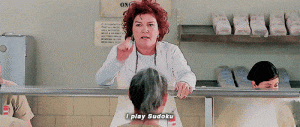A typical episode of Orange is the New Black goes like this: we open a relevant scene from Piper’s pre-prison life. Flash to Piper’s life now, in Litchfield. Plotline begins to develop, related to another character as well. Flash to that character’s past life. Flash back to Piper, in prison, with said plotline. More flashbacks to reveal the background of the other character. Repeat.
Although difficult to follow sometimes, the transitioning back and forth through different scenes does wonders for how the story is told and for the viewers’ understandings of each character. Episodes tend to follow one character and their involvement with Piper heavily, so the exposition of each character comes out by episode. For example, while Piper fights back and forth with Red, the kitchen boss, we see scenes of Red’s past life in Russia where she is alienated and rejected by upper class society. These flashback scenes allow us to understand Red’s deep pride, which Piper repeatedly accidentally insults, and to empathize a bit more with her. She is no longer a crazy, evil Russian lady but instead someone who has also loved and lost and is suffering her punishment.

We love a humanized character.
Flashing back to Larry, Piper’s fiancé, and the rest of her family and friends allows the audience to also remember that life is continuing without Piper, bringing up a very real conflict that many long-time prisoners experience – they are disconnected from their families, friends, jobs and all other aspects of their life, leaving them with very little left of what they had before when they are finally released. Although Larry attempts to continue to involve Piper, including trying to have her listen in to a call with a Barney’s executive regarding her soap line, there are small signs that he is beginning to re-adjust to life without her, including hiding her picture as he watches Mad Men without her (something that he had promised not to do).
Notable also is the lighting, and the stark variance of the lighting between real-life and flashback. While showing prison scenes, the lighting is fluorescent and sterile; it gives the impression that the inmates are just that, and there is no coziness. Even at night, the highlighting that allows the audience to observe what is occurring is white and cold instead of yellow and warm, as a night light would be. In contrast, almost all flashbacks have softer lighting. They feel homier, friendlier and happier, even when the events depicted may not be. Here, the filming clearly aims to invoke feelings of emptiness, general hopelessness and longing for freedom while the inmates are shown in prison and aims at showing their happiness and satisfaction with life outside of prison.
Through this method of storytelling, viewers find themselves respecting and empathizing with each character, not just the protagonists, and they can begin to see the events of the show unfolding from different perspectives. It is genius, really – and we get sucked into it every time.
